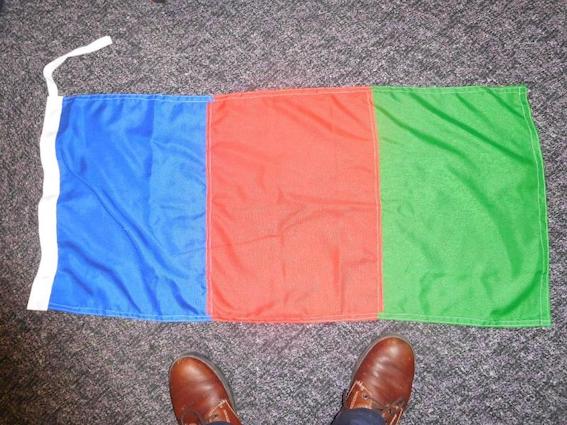The first article on an English republican flag has been written by James Gallacher of the Republican Socialist Platform. The second on a Scottish republican flag has been written by Allan Armstrong (RCN-RSP).
A new republican flag has been designed to represent a new republican identity in a new England. The colours identify with the most important popular struggles that have shaped England’s parliamentary democracy.

The tricolour design connects England with the the UK’s ‘next door neighbours’, Ireland and France who both fly tricolours. Lesser-known republican tricolour flags are also used in Wales and Scotland. The three vertical stripes stand for a society which values liberty, equality and solidarity. This is a secular and republican flag and points to a future England founded on the sovereignty of the people; at present we live under the sovereignty of the crown and its anti-democratic powers
St George was a Christian royalist. The St George’s cross is associated with the crusaders and although some sections of the left and of English society have tried to reverse this, it has strong connotations to the English far right. According to some interpretations, the dragon symbolises feminine energy, which is annihilated by the aristocratic patriarch chevalier. Its time to do away with this barbaric medievalism.


The new republican flag goes back deeper in time, to the pre-Christian and primordial era. Specifically the red stripe is linked with anthropologist Chris Knight’s idea of the role of early women and red’s cultural symbolism.
Blood Relations: Menstruation and the Origins of Culture
chris knight radical anthropology
Archaeology has shown that red ochre decoration was one of the earliest forms of artistic human creativity and expression.

Following this prehistorical symbolism, the flag’s historical referencing then jumps forward to the Levellers, the democratic party of the English Revolution in the 1600s. Levellers formed the most advanced pro-democratic wing in the New Model Army. They identified themselves by sea-green ribbons worn on their clothing.

This thread continues to run, stopping next at the Chartist movement of the 1800s and the Suffragettes of the 1900s, the most important popular struggles that have shaped England’s parliamentary democracy, fighting for the vote. Both the Chartists and the Suffragettes had their own tricolours, and the new English flag pays homage to them by essentially amalgamating their flags.


The Chartist tricolour was Red, White, and Green (top to bottom, horizontal stripes). Coincidentally this is now the Hungarian flag, except for a different shade of green.

The Suffragetes’ tricolour was Green, White and Violet/Purple (Give, Women, Votes). It is still in use, for example by the WASPI.

So to be clear:
Red for a social republic (Chartists),
Purple for the Suffragettes,
Green for the Levellers.
Green also represents a concern for the environment, as well as England’s Irish community (who did so much to advance republican and internationalist thought.
_________
2. A Scottish Republican Flag
In Edinburgh RIC we began discussions before the October 2018 Edinburgh AUOB about what banners we should take to the demo. We had already made a tentative Scottish Republican banner, to go along with the Irish, Welsh and English republican banners.

In the end it was decided not to spend money on promoting a more tentative Scottish republican flag but on the 3 large banners which led off the RIC contingent on the AUOB demo.
(ALL UNDER ONE BANNER DEMO, EDINBURGH, 6.10.18, – Photos)

Here is the thinking behind the colours chosen for the Scottish Republican Tricolour.
Blue– the colour of the radical Covenanters
Red – the colour of the social republic (which appeared in the Naval Mutinies in 1797 and Merthyr Rising in 1831, but became a key symbol of the social republicanism of the 1848 Spring Time of Peoples)
Green – the colour representing Scotland’s Irish community (who did so much to advance republican and internationalist thought from the 1880s onwards and contributed so much to the 2014 vote of Glasgow, Dundee and West Dunbartonshire and North Lanarkshire to secede from the Union)
However, these three colours can also be taken at two other levels
Political
Blue -a generic colour for Scotland
Red – The Paris Commune took over the red of the early social republicans. It could also perhaps be linked with Chris Knight’s idea of the role of early women and the cultural symbolism of red in:- Blood Relations: Menstruation and the Origins of Culture
Green – A concern for the environment
Physical/Environmental
Blue – the seas and skies of Scotland
Red – the red soils of the Borders, the red shales of the Central Belt, the red rocks of the Highlands (e,g, Red Cuillin)
Green – the forests and fields of Scotland
However, we should return to the issue of a Scottish republican flag given that the official traditional Scottish is flag, the Saltire is a its Christian symbol), like the English Cross of St. George And they are combined with the St Partick’s cross (the Anglo-Irish ascendancy’s choice) in the Union Flag acting as a continuing symbol for British conservatism and reaction upholding the UK state. .Ireland has three flags which are not part of this unionist tradition –
1. the traditional – Irish Harp

2. republican – Irish Tricolour

3. socialist republican – Starry Plough

Scottish republicans could perhaps promote the suggested Scottish republican flag. Furthermore, here is a challenge for RSP artists – design a Scottish equivalent of the socialist republican Starry Plough!
________
also see
What does the Union Jack tell us about the UK? – Allan Armstrong
http://republicancommunist.org/blog/2021/10/27/what-does-the-union-flag-tell-us-about-the-uk/
